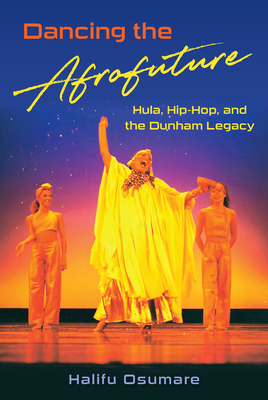Book Review: Dancing the Afrofuture: Hula, Hip-Hop, and the Dunham Legacy
by Halifu Osumare
Publication Date: Feb 14, 2024
List Price: $35.00
Format: Paperback, 336 pages
Classification: Nonfiction
ISBN13: 9780813080345
Imprint: University Press of Florida
Publisher: University Press of Florida
Parent Company: University Press of Florida
Read a Description of Dancing the Afrofuture: Hula, Hip-Hop, and the Dunham Legacy
Book Reviewed by Karen Brown
I had just recently attended the 2024 International Conference and Festival of Blacks in Dance in Memphis, Tennessee, and left the conference feeling energized. So, I was eagerly looking forward to reading the autobiography Dancing the Afrofuture: Hula, Hip-Hop, and the Dunham Legacy by Halifu Osumare. The author of three other books, including Dancing in Blackness: A Memoir and The Hiplife in Ghana: West African West African Indigenization of Hip-Hop, Osumare’s latest is a notable addition to the library of works about the history of Black dance. The tone of her latest memoir is that of a woman telling the story of her life and its trajectory from dancer to choreographer to writing about the potential of scholarship in revealing and documenting underrecognized stories of Black dance and global pop culture, each reflection demonstrating the wisdom acquired or recognized as a catalyst to continue evolving.
Osumare, who has been a dancer and educator, reminds the reader of the important body of work that was left for us to study by the late Katherine Dunham, a legendary dancer, choreographer, and anthropologist. In her latest book, she shares engaging stories about her own life as dancer and teaches us that the foundation behind The Dunham Technique was not only about dance. One of the Dunham theories, Socialization Through the Arts, the integration of mind, body, and spirit, was a socializing tool that developed productive citizens as leaders in the world. She explains early on that having been mentored by Ms. Dunham in the late 1980s, credit is due to Dunham for Osumare’s unique synthesis of the Dunham legacy and how she accomplished it as a central theme of this book.
The memoir chronicles Osumare’s extraordinary journey to full professor from as she self-described, “young naïve Black hippie leaving the Bay Area and becoming an American expatriate in Europe while building her first credits as dance artist, to dancing professionally with Rod Rogers Dance Company.” It also chronicles the discovery of her dance roots while living in Ghana, West Africa; returning to the Bay Area to create large arts projects that required administrative, artistic, and spiritual skills that she developed at the Malonga Casquelourd Center for the Arts with her Black Choreographers Moving Toward the 21st Century. Other notable projects include Everybody’s Creative Arts Center/CitiCentre Dance Theater; the historic Katherine Dunham Stanford University Residency in 1989; and the 1994 Dunham Hawai’i Residency. She taught dance at Stanford University for twelve years and moved to Hawaii to achieve her doctorate and recreated herself into an academic, all while studying and performing Hawaiian hula.
In the last chapter of the book, “We Got Next! From the Afro-Present to the Afrofuture,” Osumare writes, “Ironically, the term “Afrofuturism” was coined by white pop culture critic Mark Dery in 1994. …Dery defined Afrofuturism as ‘speculative fiction that treats African-American themes and addresses African-American concerns in the context of 20th century technoculture—and, more generally, African-American signification that appropriates images of technology and prosthetically enhanced future [This] might, for want of a better term, be called ‘Afrofuturism.’” In her book’s introduction, Osumare informs the reader that the chapter “We Got Next!” is “a deep dive into the convolutions between digital technology that shapes and directs our contemporary lives and the construct of Afrofuturism.”
I welcomed the opportunity to review this book, because the author has traversed the path I am now on. Currently, I am an assistant professor at the Conservatory at University of Missouri at Kansas City (UMKC), and beginning the journey from dancer and choreographer to scholarly writer. Like the author, as a dancer, educator and choreographer now working in academia, I am balancing the fact that my research interests are turning more toward scholarly writing with the fact that I continue to explore performing and honing my craft as a movement artist. I, too, am following the Dunham model of artist-scholar.
Dancing the Afrofuture outlines Osumare’s path to achieve tenure and how she thrived during the pandemic, talks about places she visited in Africa that had the most profound impact on her career, spotlights important moments of her personal life, and devotes an entire chapter on the distinction between dance and hip-hop. The book also includes photographs that capture memorable moments of her life and show Osumare with people who have encouraged her along her journey. All in all, this is a captivating read of one artist’s impressive journey to become an academic scholar.

